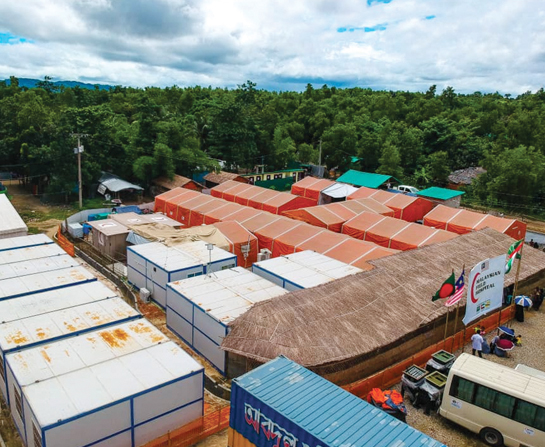WORDS RACHEL SOON
In 2017, targeted violence against the Rohingya community in Myanmar forced over a million people to flee across the border to Bangladesh. In this issue, Cpt Manvikram Singh Gill, military pharmacist with the Royal Medical and Dental Corps (RMDC) of the Malaysian Armed Forces (MAF) who was stationed at Cox’s Bazar — now the world’s largest refugee camp — shares his perspective on the first humanitarian assignment of his career.
WHAT IS THE RMDC?
The RMDC is one of the service support corps under the MAF, with the aim of ensuring military readiness and conserving the MAF’s fighting strength. The commissioned officers under the RMDC include medical and dental consultants, specialists, medical officers, dental officers, pharmacy officers, veterinarians, general and special duty officers, technical/general trades of non-commissioned officers from other ranks and files, and various allied healthcare civilian staff.
To ensure the RMDC is always well trained and prepared to face any diversified healthcare operations, apart from providing medical care to soldiers, immediate family and veterans throughout the country, the RMDC has always been actively involved in humanitarian assistance and disaster relief (HADR).
The Malaysian RMDC has an extensive track record in HADR involvement throughout the country and internationally. Among the HADR operations globally for the past 30 years are those that happened in Namibia, Cambodia, Indonesia, Somalia, Bosnia, Pakistan, the Western Sahara, Myanmar, Lebanon, the Philippines and Nepal. These operations included medical relief during wars as well as natural disasters such as earthquakes, tsunamis and cyclones.
TELL US ABOUT THE FIELD HOSPITAL IN BANGLADESH.
The situation in Cox’s Bazar (CXB) is bad. They really need assistance because their numbers are 1.5 million and increasing. The conflict intensified last year around August, when there were increased incidences of villages being burned and other violence in Myanmar. More people started coming to Bangladesh and the numbers basically just exploded.
In support of the humanitarian effort there, the Malaysian government sprang into emergency response planning. In November 2018, the Malaysian Armed Forces Health Services (MAFHS) under the leadership of Lieutenant General Dato’ Dr Ya’akop bin Koming set up a Level 3 field hospital, the Malaysian Field Hospital (MFH) in Ukhia in CXB, aiming to provide up to tertiary medical care for the refugees.
The MFH has a 50-bed capacity which can be increased up to 100 upon any medical crisis. Operations officially started 31 November 2017 after the infrastructure setup was completed by soldiers from the RMDC 2nd Medical Battalion.
For the first 3 months, it was run by medical staff from the Malaysian Ministry of Health (MOH). After the 3 months, the RMDC took over in what was named Ops Starlight-1, which I took part in. We replaced the team over there and expanded the services that were available.
WHAT ADDITIONAL SERVICES DOES A LEVEL 3 PROVIDE?
We do a lot of surgery cases. Our specialists were there for 3-month rotations providing 24/7 care for a range of specialties: anaesthesiology, family medicine, general surgery, internal medicine, orthopaedics, obstetrics and gynaecology, and public health. Medical officers, dental officers, a pharmacist and pharmacy technician, radiographers, lab technicians, medical assistants, nurses, environmental hygienists and general logisticians were also part of this team.
We are unlike the non-government organizations in that their specialists operate based on a volunteer basis and for a shorter duration, sometimes 2 weeks at most. We’re one of the few Level 3 hospitals there; the others are the Turkey Field Hospital and the Red Cross.
WHAT WAS YOUR DEPLOYMENT LIKE?
I was there for 6 months with the pharmacy technician. Initially, I received the recommendation for deployment from Colonel Mohd Adlan bin Adnan, who was the chief pharmacist at the Pharmacy Department of Tuanku Mizan Armed Forces Hospital (TMAFH), where I was stationed. Upon further endorsement from the MAFHS Director of Pharmacy, Brigadier General Dato’ Dr A Halim bin Hj Basari, I was officially selected to be deployed for 6 months, with Private Mohd Aizat bin Izzuddin as the pharmacy technician.
This mission was officially named Ops Starlight-1 with Brigadier General Dr Adnan bin Abdullah as the Commanding Officer on field, and Colonel Dr Mohd Arshil bin Moideen as the Chief Technical Planner & Advisor (Malaysia). I was made responsible for the pharmaceutical and medical logistics (PharmaMedLog) aspect, and we were tasked to prepare necessary documentations and any medical commodities for deployment.
Prior to my deployment, the MFH had already been operational for 3 months, so PharmaMedLog had to be resumed and maintained, not initiated. So, on detailed medical intelligence, surveillance on existing stock and requirement discussion with all specialists, it was decided that all PharmaMedLog items such as drugs and disposables would be acquired locally in Bangladesh instead of bringing them from Malaysia.
I also had to look into pre-deployment personnel medical requirements such as vaccinations needed — as there was a diphtheria outbreak on-field — and prophylaxis drugs since Bangladesh is a malaria-endemic country.
Pvt Aizat and I arrived in Bangladesh on 23 February 2018 as part of the advance team. On 24 February 2018, the RMDC fully took over MFH operations from MOH staff, fully resuming MFH operations upon the arrival of the main team a week later.
WHAT WERE YOUR DUTIES ON-SITE?
For outpatient pharmacy services, we saw about 400 to 500 people a day. Overall, we treated about 23,000 people in a 6-month duration. Pvt. Aizat and I both worked closely doing filling, labelling and dispensing. The medication labels were customized using pictograms to ensure that the patients understand fully the medication instructions.
We also picked up basics of the Bengali and Rohingya languages and decided to dispense medication ourselves rather than using the limited manpower of local translators hired. This was to avoid any miscommunications in medication instructions and to ensure that only a credentialed person was dispensing.
For inpatient pharmacy services, the routine included drug distribution activities such as ward unit-of-use supply mechanism; supplies for floor stock, emergency trolley medication, psychotropic and dangerous drugs; and bedside dispensing for discharged patients. Ward pharmacy activities were minimal as it was based on any opportunity I could get away from other workload. However, medication counselling, especially for inhalers, was something compulsory for me to attend.
The backbone of MFH pharmacy services is the PharmaMedLog aspect. It was crucial that drugs, disposables, lab reagents and medical gases were not only available for doctors, but that these items should be of highest quality, safe, proven effective, and acquired with minimal cost. Hence, I spent most of my time ensuring that the procurement plan that I devised was functional.
To achieve this, I had to maintain good working alliances with various stakeholders. My task was certainly effortless with great teamwork from all specialists involved and the MFH administrative leadership, which always focused on working closely with other counterparts to achieve a common goal.
We also worked together with the governments of Bangladesh, the UAE, Saudi Arabia and Brunei, as well as global agencies and non-governmental organizations (NGOs) such as the WHO, various arms of the United Nations, the Red Cross and Médecins Sans Frontières (MSF). Malaysian NGOs such as the Islamic Medical Association Relief Team (IMARET), Malaysian Relief Agency (MRA) and Mercy Malaysia were also involved.
The setting up of the MFH was an act of humanitarian response by the RMDC, and also gave the opportunity for RMDC personnel to train on how to function in times of crisis in the global arena. Personally, in the 6-month deployment, I have certainly gained a lot in terms of military medicine and military pharmacy practice.
WHAT DID YOU FEEL WAS THE MOST CHALLENGING ASPECT?
Because I was in charge of PharmaMedLog and we had decided purchasing supplies in Bangladesh would save us a lot of time and bureaucracy, I had to get medical intelligence to find out which pharmaceutical companies could be trusted—because it’s not easy. Of 250 companies there, only 8 were shortlisted that we could purchase from, after my survey on whether they were fake or real medicines, whether they were effective, etc. That was the main challenge.
The other challenge was communication in terms of the language. Pvt Aizat and I had to learn Bengali and Rohingya, because we also saw the local Bengali population who were from the surrounding villages; the ratio of Bengali to Rohingya patients was something like 70%:30%. We had to treat them as well, because when you go into their area and the government has given you land there, you can’t be exclusively for the refugees.
WOULD YOU WANT TO GO BACK?
Military pharmacists go on missions on a rotation basis. Since I have been on a mission already, the next in line to go would be my junior, and so on. Although I would love to go back there again, I have to abide by the rules of the organization.







